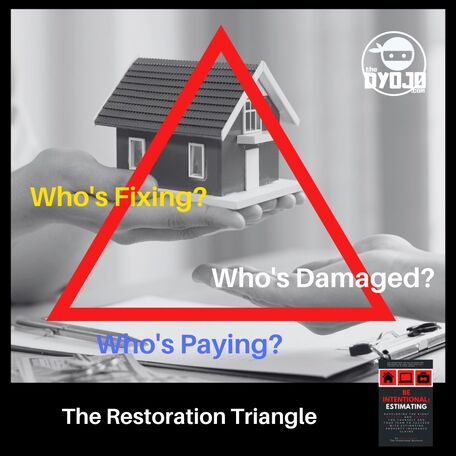|
Any classic loss is gonna at least involve three people, what we refer to in How To Suck Less At Estimating as The Restoration Triangle.
As David Princeton, guest for The DYOJO Podcast Episode 100 says, "At a minimum, those are the three those are the three people that have to be involved in the claims process." Roles in the Insurance Claims ProcessAs The DYOJO wrote about previously in Cleaning and Restoration (C&R) Magazine, Throughout his career, Pete Consigli, The Global Restoration Watchdog, trained restorers to value the Restoration Triangle. Each party brings something unique to the table that should be heard and referenced as the agreed-upon scope is established:
Pete reminds stakeholders, “If one of these parties is left out of the process of determining and agreeing on the extent of damage, scope of repair, cost of restoration to a pre-loss condition, timelines, and criteria for satisfactory completion, then there will be problems.” A claim should not follow the narrative of a T.V. drama or a strategy for Survivor, whereby two members of the triangle team up to push their narrative through. For example, the contractor and client should not be in cahoots to figure out a way to “maximize the claim” without justification. This is fraud. Neither should the contractor and the carrier be working together to dwindle the scope. This is short-changing (and likely grounds for bad faith). Contractors and Carriers Working TogetherThe DYOJO wrote about contractors and insurance carriers working together from the same site documentation in Property Casualty 360 Magazine on the topic of Expediting Claims Processing. The goal or standard of claims processing is to create an agreed-upon scope of work to restore the damaged structure to resemble its pre-loss condition with materials of like kind and quality. I believe 360-degree capture tools will continue to improve and provide a valuable resource to all parties of a claim. If we want to arrive at an expedited, agreed-upon scope of work that is as accurate and thorough as possible, everyone in the claims chain will benefit from having access to the same information. Increased capacity while simultaneously elevating data capture and collaboration opportunities would seem to be reason enough for 360-degree capture integration in the claims process. For those who are reviewing the claim remotely, ask whether the company you are working with will share their virtual walkthrough. If there is a claims question, it will be helpful to access one of these resources so that carrier, contractor, and insured (the Restoration Triangle) can virtually access the three-dimensional capture of the affected area. I hope that carriers and contractors will see the value in the utilization and sharing of these resources. This content was adapted from The DYOJO Podcast Episode 100 "Matching Materials for Insurance Claims" with David Princeton and Bill Wilson.
0 Comments
Leave a Reply. |
Words
The DYOJO - helping contractors shorten Archives
June 2024
Categories
All
EstimatingMarketingInsurance ClaimsLeadership |
|
| |||||||


 RSS Feed
RSS Feed
